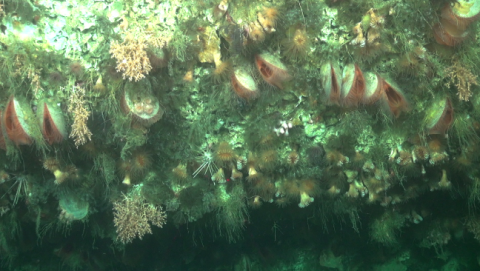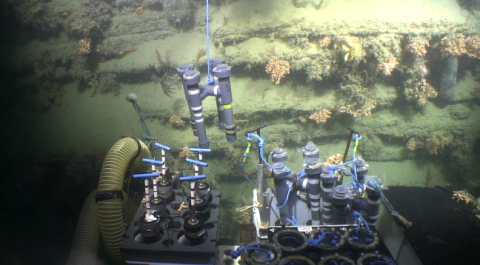Amazing Acesta: an engineering species to protect
This blog post was written by Laura Peteiro who is a postdoctoral researcher at the University of Aveiro (Portugal) working on bivalve larval dispersal patterns and Claudio Lo Iacono (NOC)
Yesterday we had a really exciting mission for ROV Isis! We did something that no one else has ever done: our amazing ROV technicians managed to secure 3 “larval traps” to a vertical wall around 1300 m below the sea surface. It is definitely not an easy task holding the traps from a vertical wall as it requires a lot of skill to maneuver the ROV. This wall dominated by cold water corals is an incredibly biodiverse habitat. These devices will be collecting larvae of different organisms for an entire year when we’ll come back to find them (fingers crossed) in a new expedition to the Wittard Canyon. We don’t know much about larval stages of deep sea animals, and these “larval traps” will give us extremely valuable information about reproduction strategies and larval availability around this peculiar habitat.
We are especially interested in collecting some Acesta excavate larvae to complement our genetic studies and understand how closely related different populations are. This clam species is commonly associated with cold water corals in the NE Atlantic and it’s highly vulnerable to habitat destruction. Acesta is also considered an “engineering species” creating tridimensional complex habitats for other species, supporting an increased biodiversity. Those qualities make Acesta a potential target species for conservation. The development of effective conservation measures, like designing Marine Protected Areas, requires more knowledge about connectivity patterns between subpopulations. This is our main objective with Acesta: trying to understand how populations are connected between different branches of the Whittard Canyon and also between other populations in the Atlantic (Portugal and Norway) where we are developing similar studies.
Today we’ll be deploying some more “larval traps” and collecting more clams in another branch of the canyon where Acesta is much more abundant. This will help us to figure out what makes these two branches so different and what are the main controls on their population dynamics. Wish us good luck!







